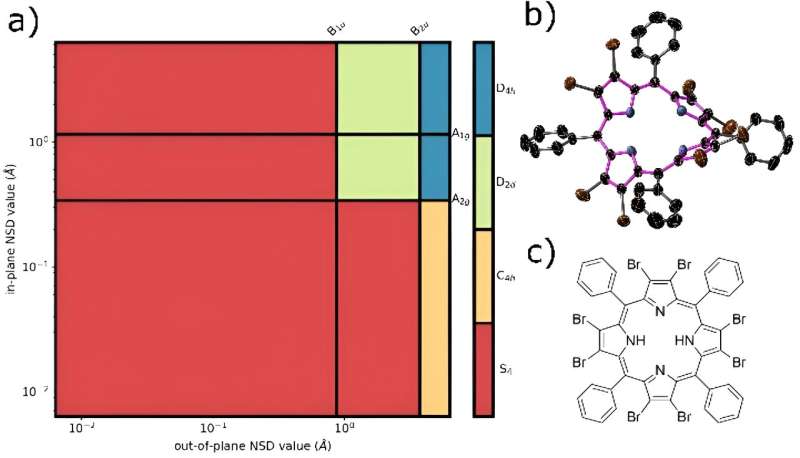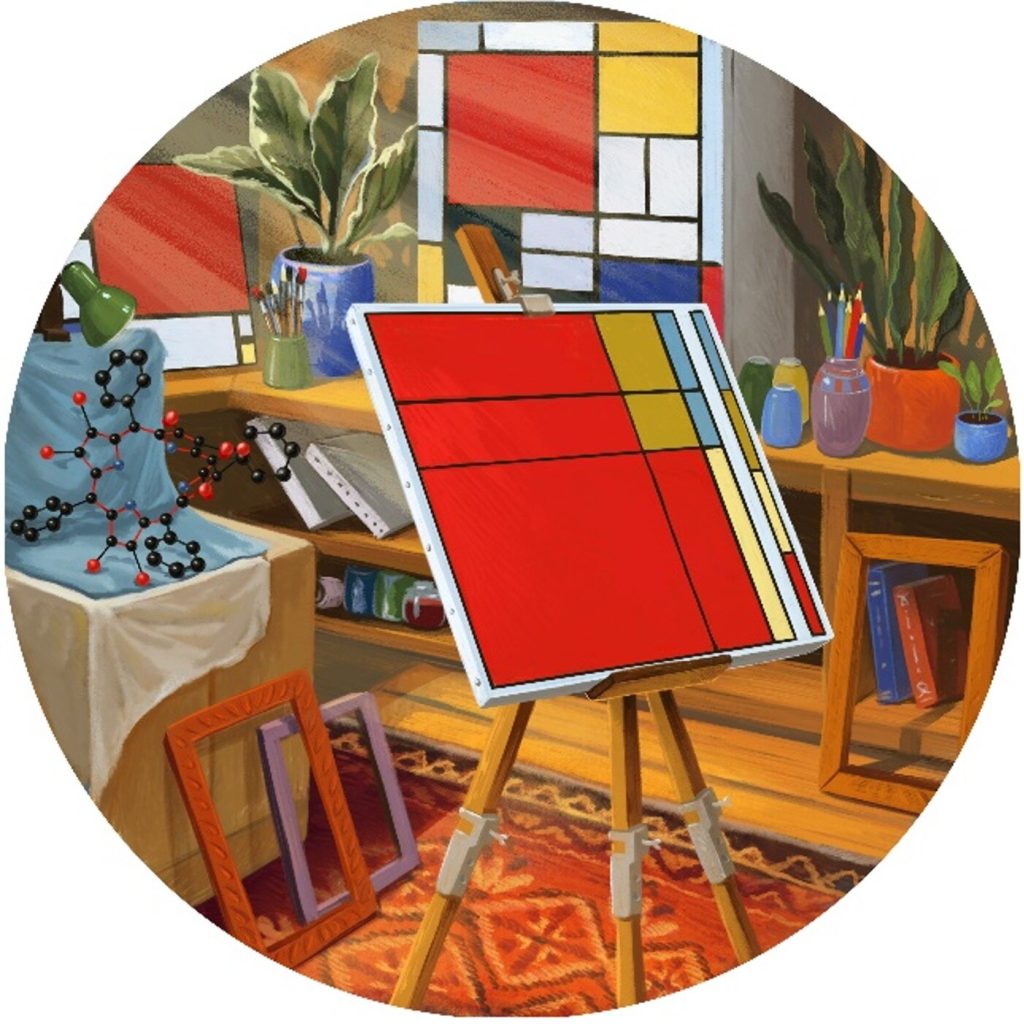An example of visual Mondrian-esque output from a specific molecular computer program. Courtesy of Professor Mathias O Senge, Trinity College Dublin.
Scientists at Trinity College Dublin have developed a computer program that “draws” molecular structures in the style of famous Dutch artist Piet Mondrian, whose beautiful works will be instantly recognizable to many.
Mondrian’s style, which uses blocks of primary colours separated by lines of varying widths on a white background, is widely imitated and used as inspiration in modern culture, but his deceptively simple works have fascinated scientists for decades, finding niche applications in the fields of mathematics and statistics.
Now, researchers in the Department of Chemistry are opening people’s eyes and minds to the beauty of molecular structure, and asking new questions about the form and function of molecules themselves.
Their computer programs are http://www.sengegroup.eu/nsdcreates a Mondrian-esque plot of any molecule, following an artistic algorithm that combines the laws of chemistry that describe a molecule’s 3D structure based on its components, with the 2D style of one of the most influential painters of modern times.
For scientists, it helps them quickly assess and demonstrate molecular symmetry, providing deeper insight than can be gained from traditional representations, and for artists, it provides visually pleasing images of contrasting interpretations of symmetry, providing inspiration for incorporating scientific ideas into their own artwork.
Matthias O. Senge, professor of organic chemistry at Trinity College and Hans Fischer Senior Research Fellow at the Institute for Advanced Studies at the Technical University of Munich, said: article In the journal, Applied ChemistryThis work will be shared with the world.
“We have been working for some years now, initially for fun, on a project to represent molecular structures in an artistically compelling way, as Mondrian-esque paintings,” he said. “The resulting ‘paintings’ would be different for each molecule, and would contrast with what Mondrian and others aimed for with their De Stijl art movement.”
“Symmetry and shape are important aspects of molecular structure and how we interpret molecules and their properties. Chemical structure And the derived values are obscured. Taking inspiration from Mondrian’s compositions, we represent the symmetry information encoded within the 3D data as blocks of color, clearly illustrating how chemical arguments contribute to the symmetry.”

a) A “tumor” diagram of the porphyrin core of a typical nonplanar 2,3,7,8,12,13,17,18-octabromo-5,10,15,20-tetraphenylporphyrin (CCDC: RONROB) and two representations of this same molecule (b) a thermal ellipsoid plot of the crystal structure and (c) a backbone model. The shape of this porphyrin is predominantly saddle-shaped, with a slight wavy shape and SFour Symmetry. Credit: Applied Chemistry (2024). DOI: 10.1002/ange.202403754
Christopher Kingsbury, a postdoctoral researcher at TBSI who conceived the project, is first author on the paper.
He said, “In chemistry, if we had a universal way of representing molecular structure, it would help us draw a ‘blueprint’ for how the molecule might behave.” Different Environments And we need to know how they react and change shape when other molecules are present, but some nuance is inevitably lost.
“This concept of removing fine details to increase abstraction and present holistic forms is mimicked in Mondrian’s early work, and in a way is what scientists intuitively do when reducing complex phenomena to ‘simpler truths’. Thanks to our new approach, highly complex science can be presented through an artistic lens, making it more accessible to a wider audience.”
In recent years, Professor Senge and his team have made significant advances in our understanding of the unique, vibrantly colored pigments known as porphyrins, also known as the “colors of life.” One piece By chemically redesigning these pigments to act like tiny Venus flytraps, capturing specific molecules such as pollutants, they have created a new set of biological sensors. And now, a new direction in which science and art collide may further our understanding of how porphyrins work.
“Great art gives us new ways of looking at the world,” Professor Senge added. “This art, as a pastiche, may help us look at things close to home.” moleculeIt helps us study organic compounds such as porphyrins in a new light and better understand how their shape and properties are intertwined.
“More generally, we believe that contemporary work in ‘art and science’ needs a transformation that breaks down disciplinary boundaries and merges into ‘art science’. There is a subtle interplay between science and art, with aspects of both blending in each field, and this should be the focus of future developments in both fields.”
For more information:
Christopher J. Kingsbury et al. “Molecular Symmetry and Art: Visualizing Approximate Molecular Symmetry in Piet Mondrian’s De Stijl” Applied Chemistry (2024). DOI: 10.1002/ange.202403754
Provided by
Trinity College Dublin
Quote: Scientists develop computer program that “draws” molecular structures in the style of famous Dutch artist (July 12, 2024) Retrieved July 12, 2024 from https://phys.org/news/2024-07-scientists-molecules-style-famous-dutch.html
This document is subject to copyright. It may not be reproduced without written permission, except for fair dealing for the purposes of personal study or research. The content is provided for informational purposes only.


